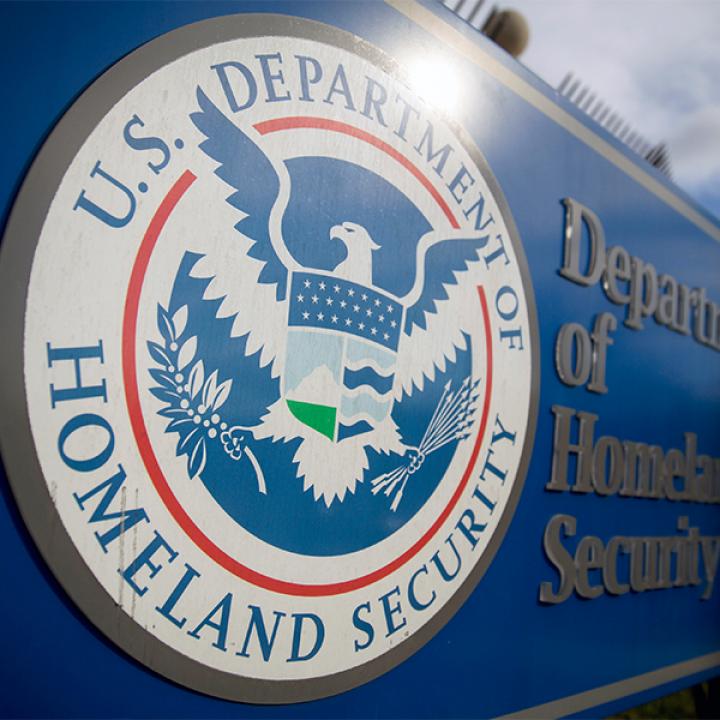
- Policy Analysis
- PolicyWatch 2893
From CVE to 'Terrorism Prevention': Assessing New U.S. Policies

Part of a series: Counterterrorism Lecture Series
or see Part 1: U.S. Efforts against Terrorism Financing: A View from the Private Sector
Four veteran practitioners discuss opportunities and risks associated with the Trump administration's shift in terminology, and policy, on countering extremism.
On November 14, William Braniff, Seamus Hughes, Shanna Batten, and Matthew Levitt addressed a Policy Forum at The Washington Institute as part of the long-running Stein Counterterrorism Lecture Series. Braniff is executive director of the National Consortium for the Study of Terrorism and Responses to Terrorism and a professor at the University of Maryland. Hughes is the deputy director of George Washington University's Program on Extremism. Batten directs the Community Resilience Initiatives Program at the University of Maryland's Center for Health and Homeland Security. Levitt is the Fromer-Wexler Fellow and director of the Institute's Stein Program on Counterterrorism and Intelligence.
WILLIAM BRANIFF
The United States does not have a grand strategy with respect to terrorism. In the sixteen years since the attacks of September 11, 2001, the United States has relied on its criminal justice and military communities, enabled by more and better intelligence, to disrupt terrorist adversaries and prevent another large-scale attack. Along the way, however, global terrorism has reached historically high levels, triggering reactionary violence and polarizing debates about immigration and refugees, nationalism and internationalism, security and liberty, and religion. Traditional counterterrorism tools are necessary, but they appear to be insufficient in terms of mitigating terrorist violence and its deleterious political consequences over time.
To complement military and law enforcement efforts -- traditional counterterrorism -- the United States and the international community entertained a different paradigm, which sought to decrease the number of individuals mobilizing to violence in the first place by addressing the individual, communal, and societal factors exploited by terrorists. This emergent paradigm -- countering violent extremism (CVE) -- has been poorly resourced, sparsely staffed, and employed as a distant second priority to traditional counterterrorism. Since its inception, CVE has been beset by detractors who see it either as dangerously idealistic political correctness or as a euphemism for predatory counterterrorism.
The two problems, the insufficiency of traditional counterterrorism and CVE's lack of traction, are directly related to an inadequate appreciation for the essential nature of terrorism. Terrorism is primarily a form of violent politics. Therefore, our response to terrorism must be primarily a political one. Given CVE's focus on contextual factors that enable terrorism at individual, community, and societal levels, CVE has the potential to alter the political conditions that allow for violent mobilization. Traditional counterterrorism lacks this political dimension. The CVE paradigm, if focused by a guiding principle, could directly inform a new grand strategic response to terrorism, with traditional counterterrorism serving in a necessary but subordinate role.
The collective grand strategy, inside and outside government, must be aimed at marginalizing terrorism. A marginalization grand strategy will help "right-size" traditional counterterrorism efforts. Establishing a grand strategy does not imply that terrorism should continue to be the highest priority on homeland and national security agendas at the expense of other challenges. On the contrary, a marginalization paradigm recognizes that terrorism is not an existential threat to the United States, may be subordinated to other national security concerns in a given region, and allows for more regionally contextualized support to partners for whom terrorism may or may not be a top priority.
SEAMUS HUGHES
Countering violent extremism at the federal level is dead. While the Trump administration played a role in CVE's demise, the responsibility falls on a number of actors. In the early days of the Obama administration, for example, the president put a hold on CVE programs, and it took two years to roll out a national strategy, "Empowering Local Partners to Prevent Violent Extremism in the United States." Now, the Trump administration finds itself in a similar position, pausing CVE programs and generally lacking any sort of coordination of CVE efforts at the federal level.
Indeed, the new CVE terminology introduced under the Trump administration, "terrorism prevention," could help narrow the issue. This term makes clear that the discussion is about programs and individuals crossing a particular threshold. Nevertheless, it only addresses violence, failing to acknowledge that extremism is also a large part of the issue.
Given the absence within the federal government of inherent advocates for such programs, a way must be found to provide incentives for CVE involvement. The Obama and Trump administrations have ceded CVE responsibility to the private sector, asking technology companies to remove extremist content from their sites, for example. This, however, is low-hanging fruit. The hard work, yet to be done, is creating prevention programs to address radicalization from an early stage.
Despite these challenges, domestic CVE programs can be saved. CVE may be moving away from the model of a federally directed program with interagency cooperation, but new efforts could empower local partners to do the work, such as in existing programs in New York and Denver. However, the federal government should be involved in quality control, encourage best practices for community engagement, and support cooperation between state and local officials.
SHANNA BATTEN
The terminology used to describe countering violent extremism efforts must convey the intention, focus, and strategy of any CVE approach. The newest term, "terrorism prevention," entails a certain flexible ambiguity. Particularly given the lack of substantive U.S. domestic terrorism laws and the hesitancy to identify certain acts of terrorism as such, notably in Charlottesville in August 2017, communities are uncertain of their role in so-called terrorism-prevention efforts. Their uncertainty leads to misunderstandings and, ultimately, ambivalence.
To build trust within communities, CVE messaging cannot be left up to random interpretation, which can result in the faulty impression that efforts to counter violent extremism are attempts, whether direct or indirect, to coopt communities into engaging in investigations and surveillance efforts. To the contrary, these efforts should remain within the purview of law enforcement and intelligence agencies.
Instead, a paradigm shift must now occur, similar to that playing out in societal understandings of domestic and sexual violence. This shift must acknowledge that violence, not ideology, is at the center of prevention work. The term "ideologically influenced violence" would clearly articulate violence as the target, while demonstrating that the U.S. government recognizes a variety of ideologies and a spectrum of radicalization. Indeed, shifting the language is the first step to achieving a transparent strategy and actual improvements in this form of violence prevention. Transparency in strategy, for its part, provides communities with concrete information and helps establish the trust critical to building their resilience.
Ideologically influenced violence can be addressed in a hands-on way at both micro- and macro-community levels. The federal government, which is best positioned as a convener and supporter for such activities, must likewise invest in the needs of communities. Meanwhile, comprehensive prevention means listening to communities and meeting them where they are -- taking in both their vulnerabilities and their priorities. Using an assets-based approach, actors must collaboratively determine what resources and networks can be best employed to strengthen communities. Such a strategy must be flexible enough to be adapted to different communities. It must also build awareness that radicalization to violence is a process and that prevention efforts must respect civil liberties.
MATTHEW LEVITT
Adopting "terrorism prevention" to describe CVE efforts may not seem a particularly consequential change in language, considering that CVE terminology has gone through many iterations in the past few years. In fact, changing the lexicon could be a positive thing, since many people outside the Beltway are uncomfortable with the term CVE. What is troubling is that the new terminology does not make clear how much room it leaves for genuine prevention efforts, or what types of terrorism will be its focus.
While the Trump administration's evaluation of CVE programs continues to develop, some change is already evident. The Department of Homeland Security has put greater emphasis on allocating grants to law enforcement over community service organizations, and to groups addressing Islamist extremism over other far-left or far-right extremism. Indeed, many people and organizations are uncomfortable accepting these grants because of the heavy and nearly exclusive focus on law enforcement and Islamist extremism.
Further, redirecting CVE terminology to focus specifically on "terrorism" may undermine efforts to convince community members that they are part of the solution to violent extremism in their communities, rather than, potentially, part of a problem. A public health model that moves beyond an exclusively law enforcement focus, and instead involves community members, would be a more worthwhile CVE approach. Indeed, law enforcement agencies themselves typically clamor for just such an approach. Additionally, it is important to consider the sources of funding for CVE programs, because these too send a message. The U.S. Departments of Health and Human Services and of Education, for example, have huge pots of money that could be dedicated to prevention efforts, but these may not be available for a program focused exclusively on terrorism prevention.
Meanwhile, focusing on border-protection solutions in the wake of terrorist attacks is easy politics but poor counterterrorism policy. Protecting our borders is important, but alone such a policy ignores the reality that radicalization happens here in the United States. Radicalization does not stop at the border, so it is critical to have programs that address violent extremist ideologies early on, and work to counter a broad spectrum of extremism, including Islamist, right-wing, and left-wing extremism, as well as other at-risk behaviors in a community. It is not clear that "terrorism prevention" will fit this bill.
This summary was prepared by Aviva Weinstein.








